1992 Brazilian Grand Prix report: 24 carat victory
McLaren gave its new weapon its debut in Interlagos, but still those Williams FW14Bs ran away and hid in the 1992 Brazilian Grand Prix as a Mansell hat-trick drew him level with Fangio's 24 GP wins
Ayrton Senna’s body language said it all. His car stammered into the pits, the Brazilian gave its misfiring Honda V12 the big rev, then wriggled out and stalked to the back of a McLaren pit which was already accommodating team-mate Gerhard Berger’s similar new MP4/7A. The Brazilian GP was just 18 laps old, and here was not one but two of the Woking cars ready to pack away. It was a sign of the new times that have come to Formula One, the last wave in a sea of desperation that washed over the team in South America as the two Williams FW14Bs of Nigel Mansell and Riccardo Patrese once again stamped their utter authority on a 1992 World Championship event.
McLaren has an awful lot riding on its new car, just as Honda has on its thoroughly revised engine, but this was not a debut that lived up to the heritage of previous models from its stable, such as the MP4/2, MP4/2B, MP4/3, MP4/4 and MP4/6 that each won first time out. That’s part of the problem of success; failure must inevitably follow at some stage. For McLaren, it has come as a result of the remorseless tide of Williams technical development.
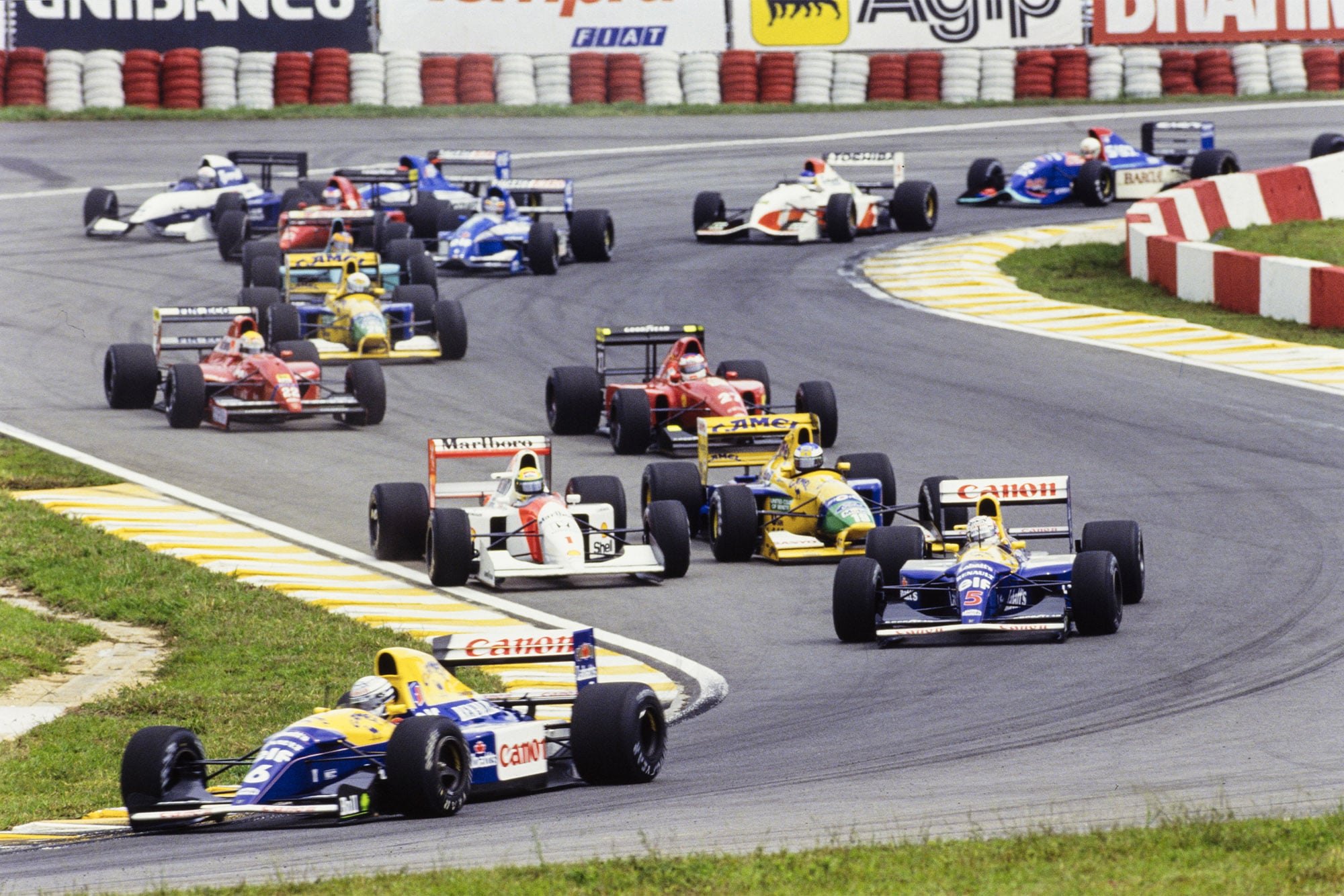
Riccardo Patrese leads team-mate Nigel Mansell through turns one and two
Motorsport Images
“It’s not a case that McLaren hasn’t worked hard,” said Senna thoughtfully, even before the defeat. “We have had technical problems, but that is reality. Our new chassis was delayed by the problems that we had in 1991 especially at the beginning of 1991 which needed to be addressed. We reached Williams in 1991 to take the title, but the effort necessary was enormous and really hurt us for the beginning of 1992. The technical difficulty of the last two years has been the problem to keep winning. Williams concentrated all of its energy in putting out something very good. It restructured for its future, and as a result it is now having a sequence. McLaren was more consistent, to hold its level. This is all very hard for McLaren no matter what the investment for this to happen. We are now in a very difficult position, but it’s something that has been corning for a very long time now . . .”
Hard words, sure, but an indication of the stakes in F1. Yesterday’s ally is the man who must work harder today. It was noticeable that when Senna left the circuit on Saturday evening, having qualified a dramatic third but a whopping 2.2s off Mansell on pole, his pace was such that Ron Dennis walked two steps behind him.
There had been one spot of humour for Senna during the weekend, and it came in the closing stages of qualifying as Mansell tried to pass him going into the right-hand Bico de Pato corner. “I don’t hold any blame on Ayrton at all,” Mansell had said. “I think it was miscommunication.” “That stupid bleep’s just driven into the wall,” the world champion is reported to have said over his radio.
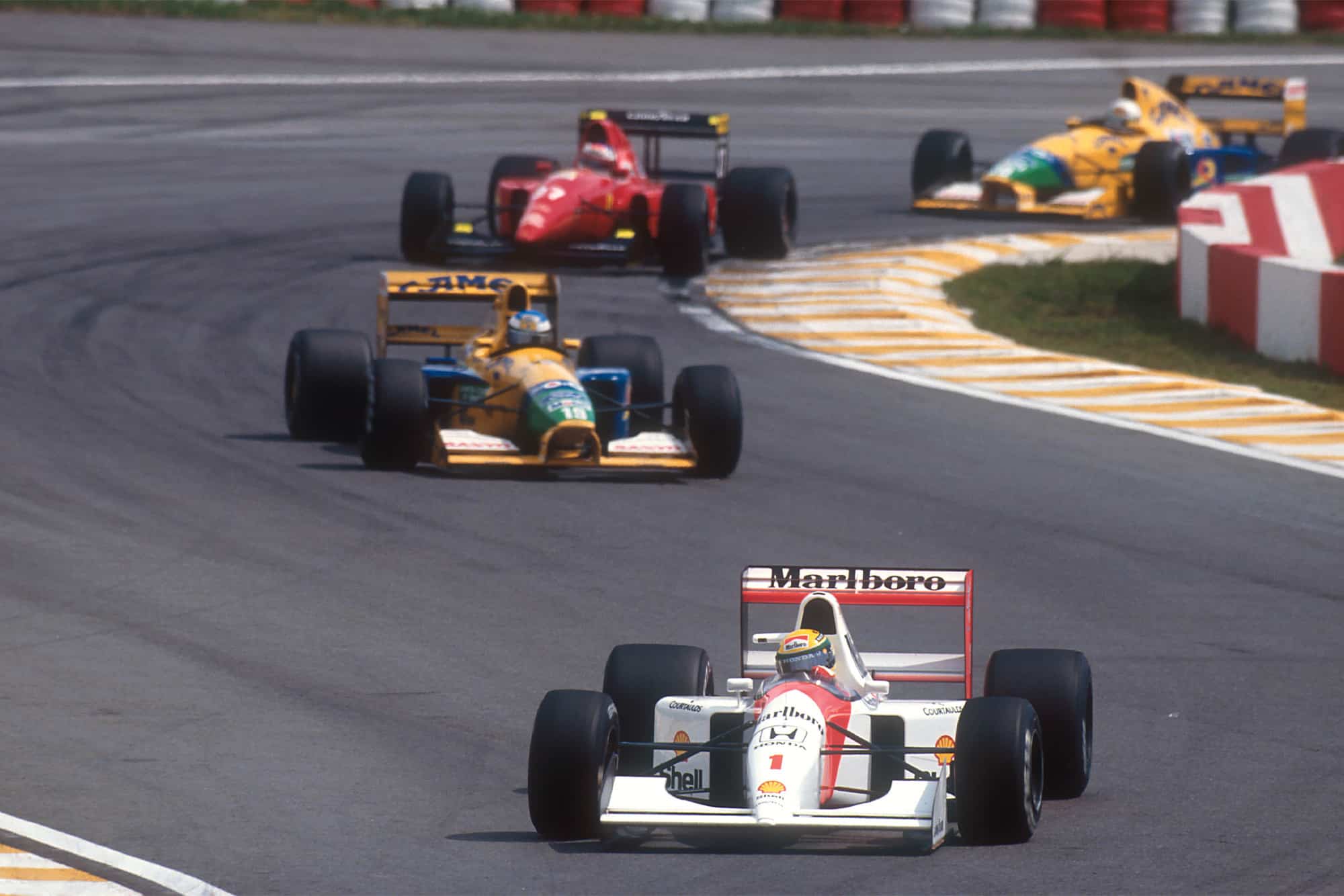
Ayrton Senna leads Michael Schumacher and Jean Alesi
Motorsport Images
For Mansell, that was the only real low point of a weekend in which he was absolutely stunning in qualifying nobody ever got close to the 1m 15.703s pole time that he set within moments of Friday’s afternoon session getting underway. That, and the start. He anticipated the lights fractionally, braked, then got excessive wheelspin as he realised his error. Riccardo, meanwhile, zapped off the line and into the lead. Maybe he was using the traction control (almost certainly he was), and probably Mansell wasn’t (nobody was saying), but in any case it only works in the upper gears, not first. In the lowest gear the car needs to be able to spin its wheels to slingshot off the grid.
Whatever, Mansell, like Senna who’d almost made the same mistake, recovered amazingly quickly. Nigel was right with Patrese as they spiralled down turn one, while Senna just kept coming and coming round the outside of a startled Schumacher. By the right flick on the exit to the corner the McLaren was alongside the Benetton, on the inner line, and the corner was the champion’s. It was a nice bit of tenacious driving, while Schumacher was smart enough not to try turning into a gap that was rapidly being filled with McLaren. Once again, it was an index of the German’s racing nous.
Mansell had a very close look down the inside of Patrese as they turned on to the back straight, but Riccardo slammed that door. For the next 31 laps the pair of them treated everyone in Interlagos, or watching their television screens around the world, to a display of superb motor racing. No quarter asked, nor given. Frank can be forgiven if he blanched during that opening lap, but his charges were too smart and too experienced to take one another off, even if they were at times only inches apart. After South Africa and, to a lesser extent Mexico, Riccardo was smack back at peak form, perhaps stung a little by the speed Mansell had shown when the Briton had been sent out in the Italian’s chassis for ‘comparative’ tests during practice. The gap fluctuated as they dealt with traffic, sometimes extending to as much as 1.3s, but usually little more than half a second covered them. Mansell drove beautifully to recover any ground he lost, Riccardo to maintain his lead under such pressure. The tyre stops were clearly going to be crucial.
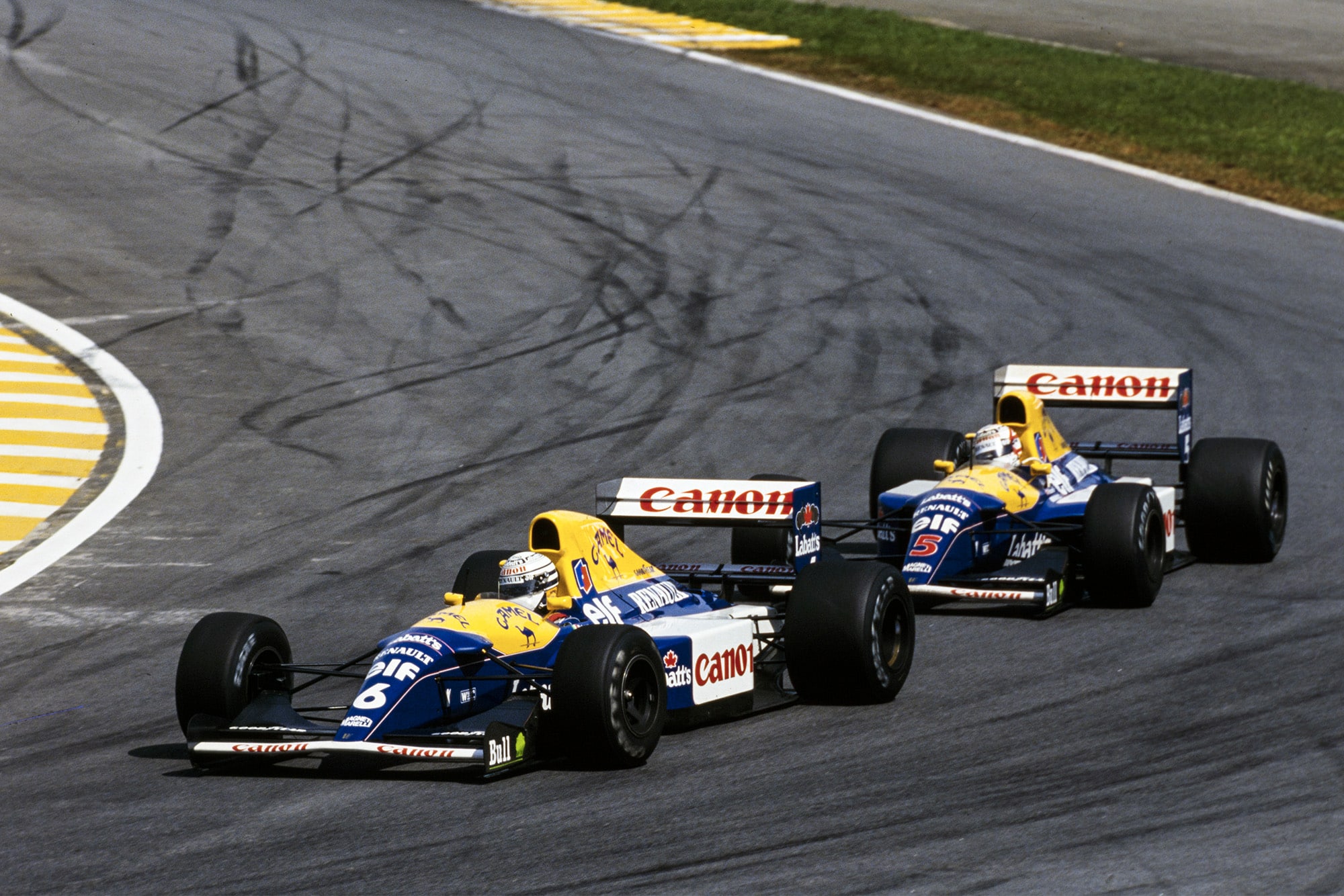
Patrese is shadowed by Mansell
Motorsport Images
Schumacher and Martini, third and sixth respectively, were the first to come in, on lap 24. Alesi (then third), Wendlinger and Herbert came in a lap later, Brundle and Alboreto another lap later still. Then it was Boutsen and Capelli at the end of lap 27. Still the two Williams stayed out. From 1m 20s early on, their lap times had eased out to the 1m 23s, but clearly the active cars were kinder to their tyres. And this while running away from the rest of the field at two seconds per lap in the opening battle! If anyone needed graphic evidence of their technical superiority (and the suspension had been made even better for Brazil), they need look no further than that.
In the end, it was Mansell who stopped first. peeling into the pits at the end of his 29th tour. It was a quick stop, occupying only 8.5s, and there was nothing but calm in the pitwork. No Estoril here. Riccardo stayed out until the end of his 31st lap, and his stop took just over nine seconds. Since his tyre swap Mansell had switched off his rev limiter and was charging. On laps 29 and 30 he had lost 20.55s in addition to the half second he had been down on Patrese on lap 28, making a total of 21.05s. But over laps 31 , 32 and 33, the first on which both drivers were back up to racing speed, he made up 26.435s, giving him a lead of 5.385s by the time the event had stabilised again after the stops. Thereafter he and Riccardo kept at it, matching one another’s times until common sense dictated that Riccardo back it off a little so both could be sure of securing Williams’s third consecutive 1-2.
In the early stages Senna’s tenacity had earned him third place, even though Schumacher surged by round the outside of the long, long left-hander leading on to the pit straight on lap eight, but the manner in which the Brazilian then repassed on the run to turn one upset the German. Later, he would launch into a criticism of the world champion’s tactics, accusing him of being obstructive. In truth, the McLaren’s Honda V12 was cutting out intermittently, giving Senna a hard time in the cockpit. Behind him no fewer than 10 cars were virtually nose to tail, Brundle chasing after Alesi for fifth place, with Martini, Wendlinger, Boutsen, Capelli and de Cesaris all in hot pursuit. Only a little further back, and gaining ground as, amazing as it seems, the McLaren held the crocodile up, were Alboreto and Comas.
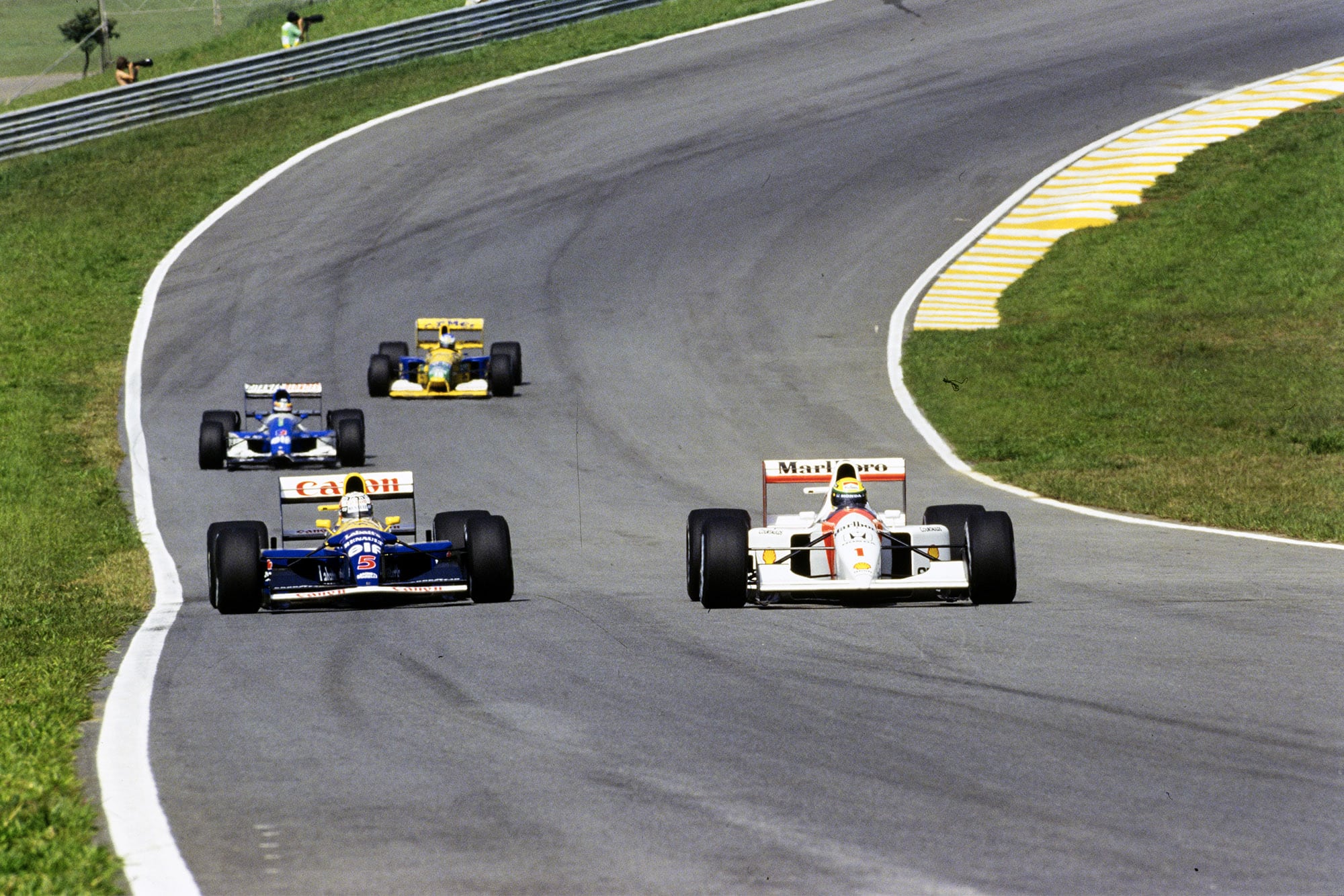
Mansell and Senna go side-by-side
Motorsport Images
When Schumacher tried again to pass Senna on lap 13 he was able to make it stick, and within a lap Alesi and Brundle’s fight had also carried them past the ailing MP4/7A. Already Berger had retired his version after only four laps with serious overheating. The Austrian had used one of the three MP4/6Bs brought along as back-ups for the three new cars to qualify fourth, but had been doomed from the start when Senna’s rejected race chassis (which he had taken in preference to his own) developed an electronic gearbox fault on the warm-up lap. He started from the pit lane, but the engine stalled while he waited as its temperatures rose, and within minutes his outing was over. Senna’s retirement brought McLaren’s agony to an end, and with it an unprecedented campaign that had seen Woking bring some 47 of its own racing personnel, numerous caterers and 23 Honda staff to the race.
McLaren’s loss became Benetton’s gain, and the B191Bs were second only to those two Williamses. Where Schumacher now had a clear run to third (albeit already 35s adrift by the time of Senna’s demise), Brundle had Alesi to contend with. This was one of the things that enlivened the Brazilian GP just as Martin’s Mexican performance had been. The Ferraris had spent qualifying testing various engine specifications, and while Alesi later pronounced: “Neither the engine nor the chassis is any good,” they were at least reliable. And with Alesi at the wheel, the F92A was quick enough to be a nuisance to Brundle as he tried time and again to squeeze by. In the end he finally gotinside the Frenchman going into the first corner, only to have Jean turn into him. Both spun, but it was the Briton who was unable to continue. “I was so mad I went looking for him,” he growled, “and that was when I realised he was still racing! I felt like throwing my helmet at his car!” Instead he took a trip to the stewards, who later gave Alesi a warning that his future conduct will come under scrutiny.
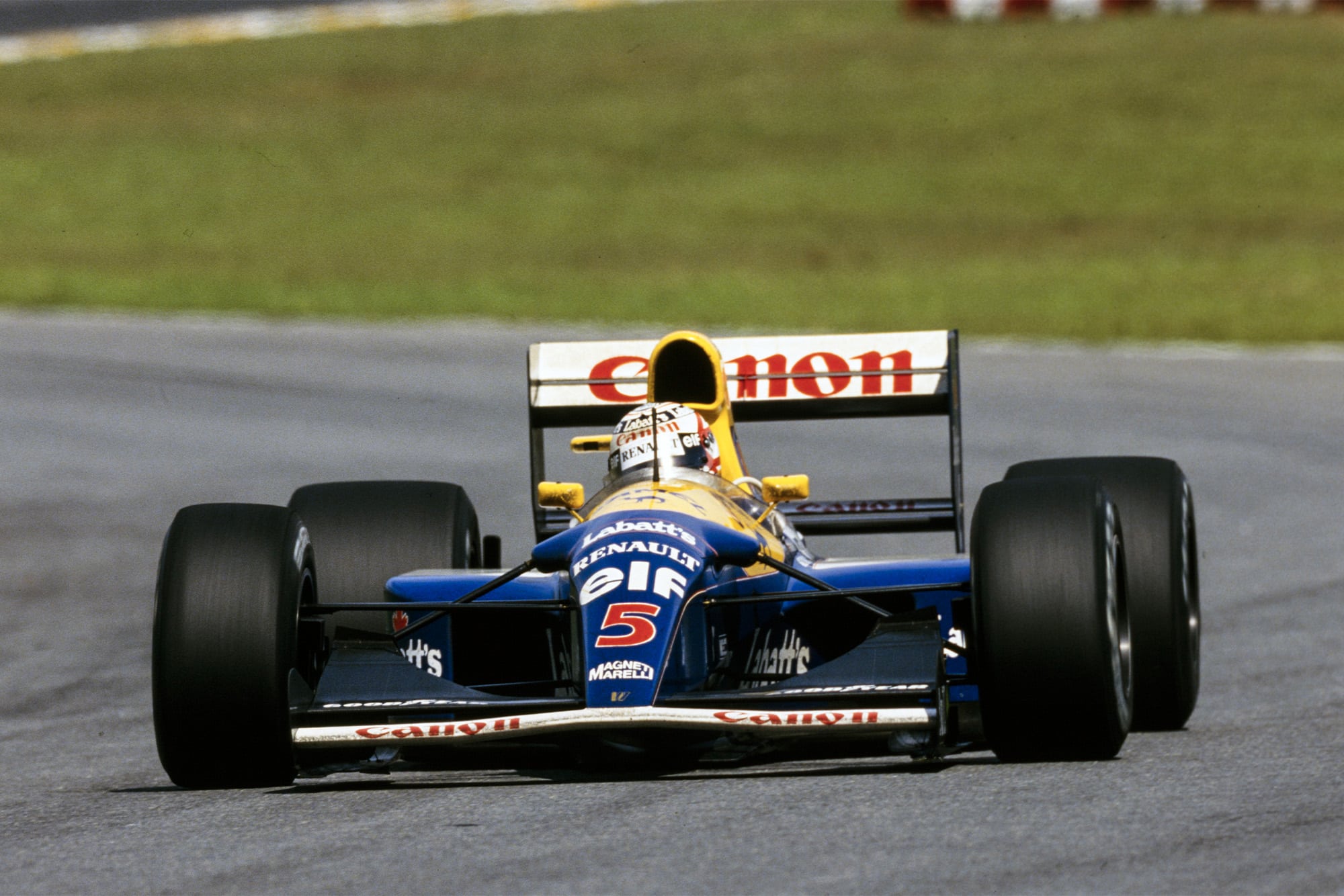
Red five out in front
Motorsport Images
They viewed it as a racing incident with provocation, but Benetton’s Flavio Briatore was dismayed by the loss of two potential points, apparently unaware of the desirability of having racing drivers who actually want to race.
By the time Brundle retired, his Benetton’s right-hand side carrying much of the Ferrari’s left-hand rubber, de Cesaris and Martini had also departed. The Tyrrell pilot had looked promising for much of the weekend, only to fall foul of an electrical problem, while Martini had been fourth fastest after Friday qualifying, only to slip to eighth when he failed to improve his time in the second session. The little Italian was running like a train between the Ferraris despite its less powerful specification version of their engine, when his clutch failed on lap 25.
Wendlinger had been charging prior to his stop, the Austrian again showing well in the March, while Boutsen also looked good and team-mate Comas ran as high as fourth from laps 27 to 31 by staying out during the height of the pit stops. When he came in, Wendlinger’s clutch was dragging and as the rear hubs continued to rotate the mechanics had a tricky time fitting the wheels. He dropped from seventh to 15th, charging again initially in pursuit of CapeIli and Alboreto for fifth place, until the clutch problem worsened and prevented him changing down.
By the time he retired, the Ligiers had already disposed of the other man who made a major impression in the Brazilian GP: Johnny Herbert. The Briton had been overshadowed in qualifying by team-mate Mika Hakkinen as he learned the circuit and they both coped with an alarming lack of grip. Indeed, he just scraped in to last place on the grid by dint of a thoroughly tweaked up lap that offended his sense of propriety but amused Mika as he watched the 102D lay massive streaks of rubber out of the turn at the end of the back straight. Lotus made some serious progress for the race, though, and by the end of the opening lap Herbert had made up nine places just as Hakkinen had in Mexico and was flying along. After an excellent pit stop he had then worked as high as a genuine seventh place by lap 32. The Lotus, however, is an elderly design and was suffering particularly through its poor aerodynamics, and lap by lap the recovering Ligier duo, Comas heading Boutsen, began to run him down.
In the French camp relations between the two drivers have become strained of late, and Boutsen was out to prove a point as he reeled in his team-mate. And just as Erik dived inside Herbert in turn one on lap 37, so Thierry went inside his partner. There wasn’t sufficient room and as the two Ligiers collided, Boutsen spun and pushed the Lotus out on to the gravel. “I tried to drive out of it,” grinned a remarkably unaffected Herbert afterwards, “but the steering wanted to go the other way!” Comas was able to carry on, but his race ended only five laps later, and Lotus’s sole consolation thus became Hakkinen’s 10th place, the Finn circulating for the final laps with only third gear. What had been a gripping race thus petered out somewhat beyond its 40 laps mark. Mansell had opened out 10.3s on Patrese as it moved to the 45th, and both Schumacher and Alesi were running alone. Capelli, however, whose head appeared progressively to be lolling more and more, could never relax as Alboreto kept pushing harder and harder in a Footwork Mugen-Honda that was finally beginning to look and go like a proper racing car. The team had lost Suzuki after only two laps to an oil system problem, but Michele was standing on the gas all weekend and thoroughly deserved the final point. For Jordan there was once more nothing but disaster wrought by further trouble with its sequential gearbox.
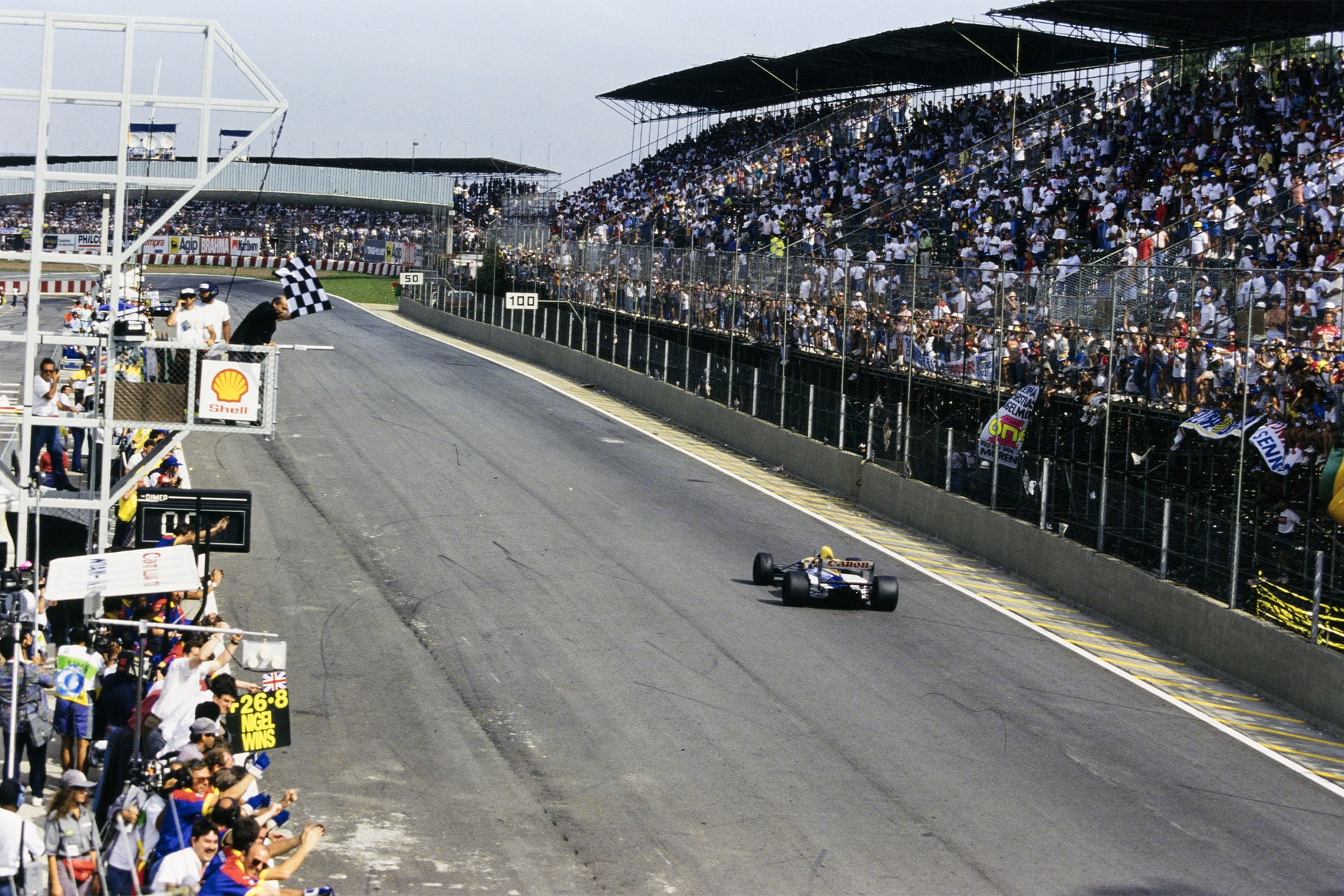
Mansell crosses the line to win as the Williams team celebrates along the pit wall
Motorsport Images
“I don’t think people realise the great job Renault has done over the winter. They have supplied us not only with reliable engines, but much more power than last year,” said Mansell afterwards as he celebrated equalling Fangio’s tally of 24 GP victories. Certainly, the Anglo-French alliance has re-written the performance parameters in dramatic style during the opening three races of the championship. But the Williams advantage did not come solely from greater power, any more than it did solely from great driving or the electronic transmission or the active suspension: it was a combination of all the factors. As the teams packed up after Interlagos, the Didcot concern had done everything right and the others hadn’t. Benetton Ford headed back to test its new B192 at Silverstone, cock-a-hoop to have displaced McLaren Honda in the chase after Williams Renault in the constructors’ championship, and Mansell’s lead over Senna had grown to 26 points. It was something the Brazilian had a month to brood over as McLaren and Honda’s connecting phone lines reached meltdown and Operation Recovery was initiated.
Williams, far from being complacent, nevertheless could reflect on a job done as well as it was possible to be done, and draw a warm glow from the presence in the wings of the FW15 and the Renault RS4 V10, neither of which will now come on racing stream until absolutely necessary. And ringing in everyone else’s ears were engine designer Bernard Dudot’s words: “We are very satisfied that for the first time this season we have totally dominated every session and the race. This victory is very encouraging for the rest of the season as Interlagos is a track which is more representative of the remaining circuits, with the exception of Monaco . . .”
BRAZILIAN GRAND PRIX, Interlagos, April 5
71 laps of 2.687-mile (4.323 km) circuit (190.807 miles; 306.960 km)
1st: Nigel Mansell – Williams FW14B-Renault V10 – 1hr 36m 51.856s
2nd: Riccardo Patrese – Williams FW14B-Renault V10 – 1hr 27m 21.186s
3rd: Michael Schumacher – Benneton 191B-Ford HB V8 – 70 laps
4th: Jean ALesi – Ferrari F92A-Ferrari V12 – 70 laps
5th: Ivan Capelli – Ferrari F92A-Ferrari V12 – 70 laps
6th: Michele Alboreto – FOotwork FA13-Mugen V10 – 70 laps
